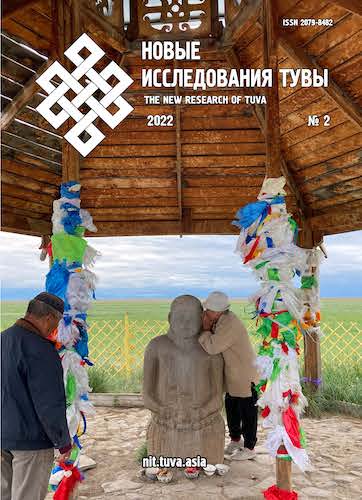Migration processes in national republics with different levels of human development: the cases of Bashkortostan, Tatarstan and Tuva
DOI:
https://doi.org/10.25178/nit.2022.2.4Keywords:
Bashkortostan; Tatarstan; Tuva; migration; migration process; intraregional migration; interregional migration; international labor exchangeAbstract
Based on statistics for 2012–2021, the article provides a comparative analysis of some migration indicators in the republics of Bashkortostan, Tatarstan and Tuva. The selection was informed by different levels of human development.
In Tatarstan, the level of human development act as a migration attractor and contribute to stable population grown due to migrants. In Tuva, they have become a repulsive force and have led to a permanent population decline. While these two republics demonstrate two opposite types of migration processes, Bashkortostan occupies an intermediate position between them and can be linked to both Tuva (for example, by the nature of interregional exchange) and Tatarstan (by some indicators of international migration). Bashkortostan occupies the same intermediate position in terms of human development.
The higher the level of human development in the region, the more stable and "calmer" the migration situation gets. Firstly, along with the positive values of migration growth, there is a relatively low intensity of intraregional and interregional exchange and high levels of the international; secondly, migration indicators do not feature strong fluctuations when external conditions change, such as during the COVID-19 pandemic. And, vice versa, the lower the level of development of the region, the more pronounced the migration decline of the population gets, and the more intensive the exchange takes place within the republic and between it and other regions, while that with other countries gets progressively weaker. When external conditions change in an underdeveloped region, migration suffers huge fluctuations. The former trend is more evident in such regions as Tatarstan; while Tuva is an example of the latter.
The direction and intensity of migration processes are also influenced by the settlement system within a region. This can be seen in the center-periphery features of migration: the population is drawn into large cities and settlements adjacent to them. This trend, although common to all of republics in Russia, is most pronounced in Bashkortostan, which has a relatively high intensity of intraregional migration. In addition, the absence of large cities and the low level of their socio-economic development contribute to a vigorous outflow of population from the republic, as it happens in Tuva.
References
Abylkalikov, S. I. (2021) Osobennosti demograficheskogo razvitiia Tuvy: vklad migratsii v demograficheskii balans [Features of the demographic development of Tuva: Contribution of migration to the demographic balance]. New Research of Tuva, no. 4, pp. 131–142. (In Russ.). DOI: https://www.doi.org/10.25178/nit.2021.4.10
Anaiban, Z. V. (2020) Sovremennaia migratsionnaia situatsiia v Respublike Tyva [Contemporary migration situation in the Republic of Tuva]. Sciences of Europe, no. 49–4 (49), pp. 62–66. (In Russ.).
Akhmetova, G. F. (2021) Dinamika trudovoi migratsii v Bashkortostane [Dynamics of labor migration in the Republic of Bashkortostan]. RUDN Journal of Sociology, no. 2, pp. 265–278. (In Russ.). DOI: https://www.doi.org/10.22363/2313-2272-2021-21-2-265-278
Badmaeva, N. V. and Natsak, O. D. (2021) Sovremennaia trudovaia migratsiia iz Kalmykii i Tuvy: ekonomicheskie, sotsio¬kul’turnye i gendernye aspekty [Contemporary labor migration from Kalmykia and Tuva: Economic, socio-cultural and gender aspects]. New Research of Tuva, no. 4, pp. 186–205 (In Russ.). DOI: https://www.doi.org/10.25178/nit.2021.4.14
Balabeikina, O. A. and Faibusovich, E. L. (2018) Uroven' urbanizirovannosti territorii Rossiiskoi Federatsii: regional'nyi razrez [The level of urbanization across the Russian Federation: regional aspect]. Geographical bulletin, no. 1 (44), pp. 72–82. (In Russ.). DOI: https://www.doi.org/10.17072/2079-7877-2018-1-72-82
Valiakhmetov, R. M. (2015) Problemy razvitiia chelovecheskogo potentsiala Respubliki Bashkortostan [Problems of human development in the Republic of Bashkortostan]. Sotsiologicheskie issledovaniia, no. 8, pp. 50–55. (In Russ.).
Valiakhmetov, R. M., Baimurzina, G. R., Turakaev, M. S., Samba, A. D.-B. (2021) Etnosotsial’nye osobennosti zaniatosti naseleniia v respublikakh Tuva i Bashkortostan [Ethnic and social aspects of employment in the Republics of Tuva and Bashkortostan]. New Research of Tuva, no. 4, pp. 206–222 (In Russ.). DOI: https://www.doi.org/10.25178/nit.2021.4.15
Egorov, D. O. and Nikolaev, R. S. (2019) Rol' migratsii v usilenii poliarizatsii rasseleniia Respubliki Tatarstan [The role of migration in polarizing the settlement pattern in the Republic of Tatarstan]. Regional'nye issledovaniia, no. 1, pp. 86–98. (In Russ.).
Karachurina, L. B. and Mkrtchian, N. V. (2010) Tsentro-periferiinye vzaimodeistviia v regionakh Rossii — analiz na osnove komponentov dinamiki chislennosti naseleniia nizovykh ATE za poslednii mezhperepisnoi period [Centre-periphery interactions in the regions of Russia: A study based on the components of the population dynamics of the grassroots ATE over the last inter-census period]. Nauchnye trudy: Institut narodnokhoziaistvennogo prognozirovaniia RAN, vol. 8, pp. 644–663. (In Russ.).
Kylgydai, A. Ch. (2020) Rol' traditsionnoi zaniatosti tuvintsev v reshenii problem rynka truda regiona: novye podkhody [Traditional employment among Tuvans and its role in solving the labor market problems of the region: new approaches]. Economics Profession Business, no. 1, pp. 65–70. (In Russ.). DOI: https://www.doi.org/10.14258/epb201960
Mkrtchian, N. V. (2018) Regional'nye stolitsy Rossii i ikh prigorody: osobennosti migratsionnogo balansa [Regional capitals and their suburbs in Russia: Net migration patterns]. Izvestiia RAN. Seriia geograficheskaia, no. 6, pp. 26–38. (In Russ.). DOI: https://doi.org/10.1134/S2587556618060110
Rybakovskii, L. L. (2017) Istoriia i teoriia migratsii naseleniia [History and theory of population migration]: in 3 books. Moscow, Ekon-Inform Publ. Book 2. Migratsiia naseleniia: iavlenie, poniatie, determinant [Population migration: phenomenon, concept, determinants]. 234 p. (In Russ.).
Rybakovskii, O. L. (2014) Rezul'tativnost' mezhregional'noi migratsii naseleniia [The efficiency of interregional migration. In: Migratsionnye protsessy v Rossii [Migration processes in Russia] / ed. by V. V. Lokosova and L. L. Rybakovskogo. Moscow, Ekon-inform. 383 p. Pp. 129–228. (In Russ.).
Riazantsev S. V. (2014) Poniatiinye apparat i istochniki dannykh o migratsionnykh protsessakh [Conceptual apparatus and data sources on migration processes]. In: Migratsionnye protsessy v Rossii [Migration processes in Russia] / ed. by V. V. Lokosova and L. L. Rybakovskogo. Moscow, Ekon-inform. 383 p. Pp. 7–32. (In Russ.).
Tinikova, E. E. (2018) Transformatsiia gorodskogo rasseleniia v natsional'nykh respublikakh Iuzhnoi Sibiri v seredine XX — nachale XXI veka [Transformation of urban settlement in the national republics of southern Siberia from mid-20th to early 21st century.]. New Research of Tuva, no. 4, pp. 235–257. (In Russ.). DOI: https://doi.org/10.25178/nit.2018.4.13
Florinskaia, Yu. F. and Mkrtchian, N. V. (2021) Migratsiia: osnovnye trendy ianvaria — fevralia 2021 g. [Migration: main trends in January and February 2021]. Ekonomicheskoe razvitie Rossii, vol. 28, no. 6, pp. 58–61. (In Russ.).
Fomkina, A. A. (2015) Slabourbanizirovannye territorii: kriterii i osobennosti vydeleniia [Under-urbanized territories: criteria and features of defining]. Vestnik Tverskogo gosudarstvennogo universiteta. Seriia: Geografiia i geoekologiia, no. 2, pp. 72–79. (In Russ.).
Khilazheva, G. F. (2021) Sovremennaia sem'ia v kontekste translokal'noi migratsii (na primere semei vakhtovykh migrantov Bashkortostana) [Contemporary family in the context of translocal migration: the case of shift migrants families in Bashkortostan]. Woman in Russian Society, no. 1, pp. 68–92. (In Russ.). DOI: https://www.doi.org/10.21064/WinRS.2021.1.6
Khol'shina, M. A. and Kylgydai, A. Ch. (2014) Territorial'noe razlichie vnutrennei migratsii naseleniia Respubliki Tyva [Territorial differentiation of internal migration in the Republic of Tuva]. Perspektivy nauki, no. 11 (62), pp. 14–17. (In Russ.).
Chelovecheskoe razvitie: novoe izmerenie sotsial'no-ekonomicheskogo progressa [Human development: a new dimension of socio-economic progress] (2008) / ed. by V. P. Kolesova. Moscow, Prava cheloveka. 636 p. (In Russ.).
Lee, E. S. (1966) A Theory of Migration. Demography, vol. 3, no. 1, pp. 47–57.
Published
How to Cite
For citation:
Akhmetova G. F. Migratsionnye protsessy v natsional’nykh respublikakh s raznym urovnem razvitiia chelovecheskogo potentsiala (na primere Bashkortostana, Tatarstana i Tuvy) [Migration processes in national republics with different levels of human development: the cases of Bashkortostan, Tatarstan and Tuva]. New Research of Tuva, 2022, no. 2, pp. 53‑69. (In Russ.). DOI: https://www.doi.org/10.25178/nit.2022.2.4
Issue
Section

This work is licensed under a Creative Commons Attribution-NonCommercial 4.0 International License.

Author(s) license holder(s) grant rights for their work to the journal (grantee of a license) under the simple non-exclusive open license in accordance with Art. 1286.1 «Open license for a research work, work of literature or fine arts», Civil Code of the Russian Federation.
New Research of Tuva publishes articles under the Creative Commons Attribution-NonCommercial license (CC BY-NC).
Since it is an open license, author(s) reserve the right to upload the article to their institutional repository, submit it to another journal (if it allows republications), or republish it on their own website (in full, or in part).
However, several conditions apply here:
a) The republished version must always contain the name(s) and affiliation(s) of the author(s), the original title and the hyperlink to the original version on the New Research of Tuva website;
b) It must be in open access, free of charge, and no category of readers must be in any way whatsoever advantaged over general readership.
c) should the contribution be submitted elsewhere by its author(s) without substantial modification (30% or more of original text unchanged), the body of the article should contain a disclaimer that the original version was published in New Research of Tuva (with a link to the respective page)
The CC-BY-NC is a non-revocable license which applies worldwide and lasts for the duration of the work’s copyright.









